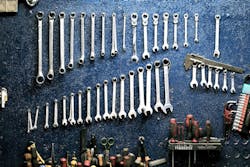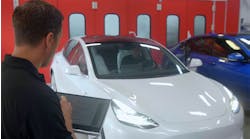July 2, 2020—The Specialty Equipment Market Association (SEMA)—along with several aftermarket companies, ADAS technology service providers and test facilities—last week announced that it had successfully completed ADAS testing of an aftermarket-modified 2020 model year pickup truck proving that it meets all functional and regulatory safety compliance standards, OEM warranty requirements, and insurance eligibility specifications.
Initiated by SCA Performance Group, an OEM-authorized specialty vehicle manufacturer for light-duty trucks, this study included the industry’s first active safety performance test on a 2020 pickup truck to assess pedestrian automatic emergency braking, an ADAS designed to prevent collisions with pedestrians.
The 2020 pickup truck tested was equipped with the following ADAS technologies as standard equipment:
-
Automatic emergency braking with pedestrian detection
-
Blind spot warning
-
Rear cross traffic alert
-
Lane departure warning
-
High-beam assist
-
Rear automatic braking
-
It was modified by SCA Performance Group with a 6-inch suspension lift kit and 35-inch all-terrain tires.
-
The ADAS sensors were recalibrated by asTech
-
P-AEB tested by the Transportation Research Center in East Liberty, Ohio
The results of the testing could potentially aid automotive performance aftermarket manufacturers by providing information, tools, practices, procedures and resources to help ensure that their products can be integrated with the latest factory-installed ADAS technologies.
As ADAS features become more in-demand with customers and vehicles—more than 60 million vehicles in the U.S. are equipped with ADAS technologies—some shops have begun to see requests from customers to install aftermarket systems in their vehicles.
Those technologies include blind spot warning and cross-traffic alert; Bluetooth connectivity; heads-up display; dash cam; and back-up camera.
ReportLinker found that the automotive ADAS aftermarket will increase at a CAGR of over nine percent from 2020 to 2024.
“The fact of the matter is, the days of letting the quality of the vehicle and the weather do our marketing are quickly coming to an end,” said Rick White, president of One Eighty Business Solutions and an industry consultant, in a Ratchet+Wrench story. “Because we don’t have those repairs, there are a lot of shops scrambling for car count. One of the ways they can supplement that car count is to add technology add-ons.”
Using technology as an additional profit center can be a way to differentiate your shop from the competition and get ahead of the curve. Working with various “add-ons” to vehicles can give business a boost, too. Installing and fixing GPS and entertainment systems and other electronic services can turn into a successful profit center for business.
Doing so, however, is more complicated than the simple radio swap-outs of yesteryear.
Among the many factors shops should consider, including the legality and whether your shop will be held liable should the system malfunction. In addition, many shops polled by ADAPT expressed that many of these systems don’t perform particularly well, and that the customer could become angry with your shop, in the event of poor performance. Some shops recommended having customers sign a disclaimer that explains it is not the shop’s fault if the provided system does not perform as advertised.
Finally, it goes without saying that your shop will need the training and capability to both install, calibrate and fix these systems.
“There’s a disparity between qualified technicians and what the independent shops need,” said Josh Mellor, owner of Mellor’s Automotive in West Melbourne, Fla., and one of the first in his area to work on these jobs, in the story. “A lot of times, the dealership-level techs have the training. I know some other shop owners and I come from the technician side, there’s weakness when it comes to the technology side of things.”
Mellor says that there is ample training available for technicians to learn programming, how to read wiring diagrams and perform these installations. And, he says, the learning curve isn’t terribly steep.
“Given the skillset most techs have when it comes to technology, it’s not anything spectacular that you have to do to install a navigation unit,” he said. “It’s a little above installing a regular car stereo.”
It makes no sense to perform these services and not let your customers know it is an option for their vehicles, White says. He suggests shifting a portion of your current marketing budget toward this aspect of your business to get the word out and position yourself as an expert, which will help attract customers.




